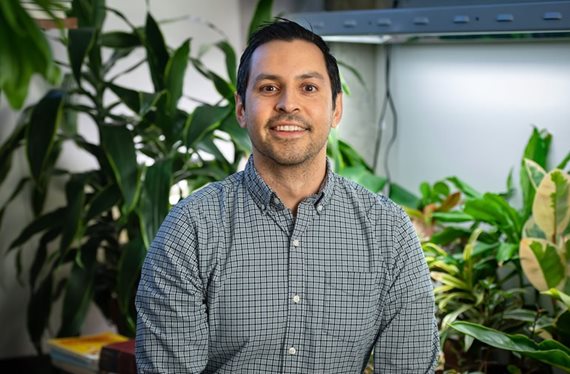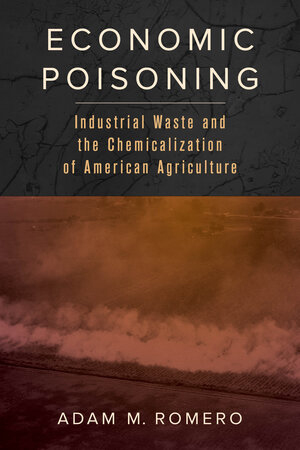
In his book “Economic Poisoning: Industrial Waste and the Chemicalization of Agriculture,” Dr. Adam Romero, an assistant professor in the School of Interdisciplinary Arts & Sciences, tells the secret history of pesticides in United States in the late 19th and early 20th centuries.
Pesticides are often thought of as a necessary, inevitable part of the agriculture process, priming soil and keeping bugs away from crops. But Romero reveals that agricultural use of pesticides helped farms become one of the biggest dumping grounds for the toxic byproducts of industrialization.
“Agriculture really played an important role in absorbing essentially toxic waste coming from other industries,” Romero said.
This is the first book written by Romero, who has been at the University of Washington Bothell for six years. While he hasn’t taught agriculture courses in a few years, he said it is an interdisciplinary topic that is connected to other fields such as business, technology, education and political science.
Ideas based in field work
Manufacturers needed to discard the toxins resulting from oil production and mining and chemical manufacturing, and farmers needed to keep pests away and soil nutrient-rich — thereby creating a mutual need. Arsenic, as an example, is a by-product of mining and smelting and was used as a pesticide.
In his book, however, Romero shows that the chemical-intensive agriculture industry in the United States was not inevitable or necessary for the country to produce sufficient food. By connecting farming ecosystems to technology and the economy, he reconceptualizes pesticides and encourages readers to rethink assumptions about food, industry and the relationship between human and nonhuman environments.
The topic of economic poisoning first sparked Romero’s interest when he was an undergraduate student at the University of California Santa Cruz. Conducting research on chemical agriculture on the central California coast, he studied the chemical loads draining from the Salinas Valley — where nearly half the nation’s lettuce, broccoli and cauliflower is grown — into the coast.
“For two years,’ he said, “I had a front row seat to some of the most intensive agriculture on the planet: the lines of refrigerated trucks waiting to disperse the berry crop across the world, the blur of machines and brown bodies that delicately ravaged a lettuce field, the million-dollar homes and elementary schools abutting strawberry fields being fumigated.”
The experience was a formative one, Romero said, and set him on the path of researching agricultural pollution and economic poisoning.
Surprising finds in archival research
To conduct his research and then write his book, Romero relied heavily on archives, such as those at the Journal of Economic Entemology and the Journal of Pest Science. Other sources of information, however, were not easily accessible.

According to Romero, due to lawsuits and other conflicts, many companies and institutions keep their records under lock and key.
The most surprising finding, Romero said, was the fact that agriculture was so critical for many industries, rather than the other way around. It wasn’t just about chemicals helping farms to produce food; it was about using soil to absorb waste and by-products. As he dug deep into his research, it became clear that most pesticides originated from toxic waste piles from non-agricultural industries.
“One of the other things that really surprised me, but perhaps should not have, was the unrelenting faith that scientists and policy makers have in industrial chemicals,” Romero said. “What’s more, the idea that organic food is somehow an alternative free from pesticides isn’t really correct.”
In the classroom, Romero presented his students with images and information comparing organic agriculture production and conventional agriculture production. “They couldn’t tell a difference,” Romero said. “The organic label tells us what inputs are used but not about how the food is grown nor its soil health, its environmental impact or the labor conditions it was grown under. It is a set of laws that often do not align with the public’s idea of ‘organic.’
“Large quantities of different pesticides are still used on organic fields. They may be less benign but many fields are simply sprayed more often. While there is organic food at the local farmer’s market, most is grown by the same corporations that grow and process all food. For them, ‘organic’ has simply become another way to add value.”
Change the agricultural framework
With all the new insights into farming that have come with writing this book, Romero said he has not changed his personal perspective on the food and agriculture industry. In fact, he has long grown much of his own food because of his expert understanding of the innerworkings and pitfalls of the agriculture industry.
These dynamics have been the same for decades — and continue to exacerbate issues such as chemical waste and overproduction. In order to make real change, Romero said consumers have to look beyond the farmers and personal consumption choices and instead focus on policymakers and the legal world.
“You can transform your own life, your kids’ lives, your family and communities,” Romero said. “But a community garden is not going to change how food is grown.
“There’s a difference between changing your own diet and changing how everyone in the nation eats.”
On to the next chapters
“Economic Poisoning” received a 2022 Cultural and Political Ecology Outstanding Publication Award in recognition of innovative scholarship in cultural and political ecology. The annual award was established by the Cultural and Political Ecology Specialty Group of the American Association of Geographers, and is given to a single publication that is clearly innovative and has the potential to be seminal in these areas of research.
Romero’s next book picks up where “Economic Poisoning” leaves off and will shed light on the overproduction of American agriculture.
The book is still many years away from being published, but Romero said he’s currently working on a chapter about the history of the Commodity Credit Corporation, a federal corporation created during the Great Depression.
“The CCC shaped agriculture and diets in the U.S. and across the world,” he said. “The chapter examines the CCC in relation to the history of financial capitalism, agrarian democracy and the thorny issue of chronic surplus production.
“I am particularly interested in how the CCC, in its quest for farmer parity, not only underwrote American farmers but also the producers of agricultural inputs such as pesticides.”


